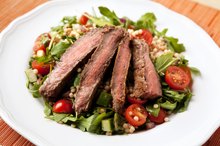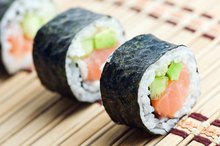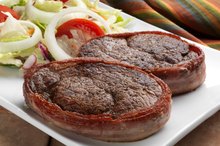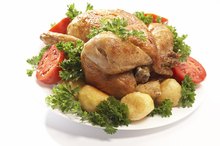What does fact checked mean?
At Healthfully, we strive to deliver objective content that is accurate and up-to-date. Our team periodically reviews articles in order to ensure content quality. The sources cited below consist of evidence from peer-reviewed journals, prominent medical organizations, academic associations, and government data.
The information contained on this site is for informational purposes only, and should not be used as a substitute for the advice of a professional health care provider. Please check with the appropriate physician regarding health questions and concerns. Although we strive to deliver accurate and up-to-date information, no guarantee to that effect is made.
Is Rare Ribeye Steak Healthy?
Ribeye steak is a cut of beef taken from the rib section of a cow. In Australasia, the ribeye cut is also known as the Scotch fillet and in the United States it may be referred to as either ribeye or rib eye. A cow's rib section, for purposes of steak cuts, runs from the sixth through 12th rib. Eating rare ribeye steak has nutritional advantages and disadvantages. Consult your doctor before making significant dietary changes.
Nutritional Information
The USDA standard nutrient database gives nutritional information for ribeye steak in both raw and broiled forms 1. This data assumes the steak has been trimmed to zero inches of fat. A trimmed raw ribeye steak from the so-called small end -- between ribs 10 and 12 -- contains 274 calories, 17.5 g of protein and 22 g of fat in every 100-g serving. Broiled, the same piece of ribeye contains 205 calories, 28.9 g of protein and 9 g of fat.
- The USDA standard nutrient database gives nutritional information for ribeye steak in both raw and broiled forms 1.
- A trimmed raw ribeye steak from the so-called small end -- between ribs 10 and 12 -- contains 274 calories, 17.5 g of protein and 22 g of fat in every 100-g serving.
Cooking Process
Serving Size for Tri-Tip Steak
Learn More
When you broil ribeye steak, water and fat drip away from the meat. For this reason, the protein content by weight of cooked steak is greater than that of raw steak. Water weight has been lost from the meat, so the protein content is more concentrated. Likewise, more than half of the fat in raw ribeye steak is typically lost through broiling. If you fry your steak, it will retain more fat than if you broil it. Cooking a steak rare rather than well-done will give less time for water and fat content to be lost from the meat.
- When you broil ribeye steak, water and fat drip away from the meat.
- If you fry your steak, it will retain more fat than if you broil it.
Food Contamination
According to the Centers for Disease Control and Prevention, consuming raw or undercooked meat can put you at risk for illness 3. Particularly, the CDC warns that the E. coli bacteria can be present in raw meat. However, tests carried out in 2004 by the UK Meat and Livestock Commission found that when it comes to steak, the risk of food poisoning is determined by the cleanliness of utensils used to handle the meat, not the degree of cooking. Rare steaks were found to be as safe -- in terms of food poisoning potential -- as well-done steaks 2.
Considerations
Gyro Meat Nutritional Information
Learn More
Ribeye steak, like all beef products, is a rich source of protein. Protein helps your body to grow and repair healthy tissue. There is typically zero carbohydrate content in a rare ribeye steak, so it is a good protein source if you are following a low-carbohydrate dietary regimen. However, there is also no dietary fiber in steak, so you would need to balance your diet to include sufficient fiber. In raw ribeye steak, almost half the fat present is saturated fat. Saturated fat is considered less healthy than unsaturated fat, according to MayoClinic.com 4. Trimming fat from your steak is important to make this food as healthy as it can be.
- Ribeye steak, like all beef products, is a rich source of protein.
- There is typically zero carbohydrate content in a rare ribeye steak, so it is a good protein source if you are following a low-carbohydrate dietary regimen.
Related Articles
References
- USDA National Nutrient Database for Standard Reference, Release 23
- Medical News Today: Eating Rare Steaks Does Not Increase Chances of Food Poisoning
- Centers for Disease Control and Prevention: Questions & Answers: Sickness Caused by E. coli
- MayoClinic.com: Dietary Fats
- Beef, rib eye, small end (ribs 10-12), separable lean and fat, trimmed to 0" fat, select, cooked, broiled. USDA FoodData Central. Updated 4/1/2019
- Glycemic index and diabetes. Medline Plus. Updated April 9, 2020
- Saturated Fat. American Heart Association.
- Appendix 7. Daily Nutritional Goals for Age-Sex Groups Based on Dietary Reference Intakes and Dietary Guidelines Recommendations. Updated 2015
- Tuso PJ, Ismail MH, Ha BP, Bartolotto C. Nutritional update for physicians: plant-based diets. Perm J. 2013;17(2):61‐66. doi:10.7812/TPP/12-085
- Wyness L. The role of red meat in the diet: nutrition and health benefits. Proc Nutr Soc. 2016;75(3):227-32. doi:10.1017/S0029665115004267
- Pighin D, Pazos A, Chamorro V, et al. A Contribution of Beef to Human Health: A Review of the Role of the Animal Production Systems. ScientificWorldJournal. 2016;2016:8681491. doi:10.1155/2016/8681491
- Bradlee ML, Mustafa J, Singer MR, Moore LL. High-protein foods and physical activity protect against age-related muscle loss and functional decline. J Gerontol A Biol Sci Med Sci. 2017;73(1):88-94. doi:10.1093/gerona/glx070
- Fuggle N, Shaw S, Dennison E, Cooper C. Sarcopenia. Best Pract Res Clin Rheumatol. 2017;31(2):218‐242. doi:10.1016/j.berh.2017.11.007
- Avoiding anemia boost your red blood cells. NIH News in Health. Updated 2014.
- Omaye AT, Omaye ST. Caveats for the good and bad of dietary red meat. Antioxidants (Basel). 2019;8(11):544. Published 2019 Nov 12. doi:10.3390/antiox8110544
- How to keep your immune system healthy. Academy of Nutrition and Dietetics. Updated 2018.
- Rasmussen NF, Rubin KH, Stougaard M, et al. Impact of red meat, processed meat and fibre intake on risk of late-onset chronic inflammatory diseases: prospective cohort study on lifestyle factors using the Danish 'Diet, Cancer and Health' cohort (PROCID-DCH): protocol. BMJ Open. 2019;9(3):e024555. Published 2019 Mar 30. doi:10.1136/bmjopen-2018-024555
- Keller U. Dietary proteins in obesity and in diabetes. Int J Vitam Nutr Res. 2011;81(2-3):125-33. doi:10.1024/0300-9831/a000059
- Micha R, Michas G, Mozaffarian D. Unprocessed red and processed meats and risk of coronary artery disease and type 2 diabetes--an updated review of the evidence. Curr Atheroscler Rep. 2012;14(6):515-24. doi:10.1007/s11883-012-0282-8
- Protein. American Diabetes Association.
- Pisazka V, Duscher G, Hodžić A, Reider N, Allerberger F. Alpha-gal allergy after a tick bite in Austria. Wien Klin Wochenschr. 2019;131(15-16):385-388. doi:10.1007/s00508-019-1506-5
- Alpha-gal and red meat allergy. American Association of Allergy, Asthma, and Immunology. Updated 4/25/19
- Saturated fat. American Heart Association. Updated 2020.
- Meadows L. What's your beef - prime, choice or select?. U.S. Department of Agriculture. Sep 12, 2019
- Beef, ribeye cap steak, boneless, separable lean only, trimmed to 0" fat, choice, raw. USDA FoodData Central. Updated 4/1/2019
- Beef, ribeye cap steak, boneless, separable lean only, trimmed to 0" fat, select, raw.USDA FoodData Central. Updated 4/1/2019
- Grass Fed vs. Grain Fed Beef. Penn State Extension. College of Agricultural Sciences. The Pennsylvania State University
- What is "grass fed" meat? Ask USDA. Jul 17, 2019
- Provenza FD, Kronberg SL, Gregorini P. Is grassfed meat and dairy better for human and environmental health?. Front Nutr. 2019;6:26. Published 2019 Mar 19. doi:10.3389/fnut.2019.00026
- Beef. Steaks. USDA FoodKeeper App. Updated April 26, 2019
Writer Bio
Jae Allen has been a writer since 1999, with articles published in "The Hub," "Innocent Words" and "Rhythm." She has worked as a medical writer, paralegal, veterinary assistant, stage manager, session musician, ghostwriter and university professor. Allen specializes in travel, health/fitness, animals and other topics.









